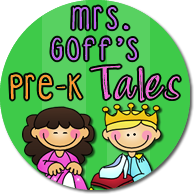I'm joining Cara's Throw Back Thursday Linky Party today. This post about how my kiddos did The Pledge of Allegiance in sign language each morning was originally published last summer.
When I taught kindergarten we started each day by saying the Pledge of Allegiance with sign language. I think the Pledge is a wonderful place to start talking about citizenship. Although most students say the pledge each day, they often say it incorrectly or without understanding what they are saying.
There are many versions of the Pledge in sign language. The one I used was a variation of one I learned at a Dr. Jean conference. I like it because it is very simple and I think it is very appropriate for young children because it slows the kids down so they say each word but it isn't so complicated that it is too hard for the children. I asked one of my former students who I found swimming at our swim club to model the pledge so I can explain the motions we use. You will notice that I don't try to put a motion to every word. While I'm not sure that a deaf person could follow our motions, I know that the motions helped my children understand the pledge. The word document showing the motions is available here.
In kindergarten, I taught the Pledge of Allegiance and the accompanying sign language motions on the first day of school. I gave brief descriptions of what the words meant when I first taught the pledge. I started by saying that most 3rd and 4th graders don't know what the words mean so it is really cool that my kindergarteners were learning such big and important words. Then, each morning, I would then ask the class about different words in the pledge. For example, I might do the motion for indivisible and then ask what the word means. The kids would say "can't break it apart" and I would act (and be) very pleased that they know such a big word.
After a few weeks, when we are really good at saying the pledge, I read I Pledge Allegiance by Bill Martin and Michael Sampson. The book is illustrated by Chris Rashka and does a wonderful job of explaining what all the words in the pledge mean. It also includes historical facts about our flag, the Pledge of Allegiance, and Christopher Columbus' discovery of America as well as facts about our country such as what the colors of our flag represent. I love Chris Rashka's quirky collage style illustrations. For example on the page that defines allegiance as loyalty, there is a little dog wagging his tail. Publishers Weekly describes the book as "simple without being simplistic, this cleverly designed volume spells out the concrete meaning behind the words in the Pledge of Allegiance while deftly communicating the democratic spirit and principles that inspired it". While I love the book, I do think the concepts are a little hard for kindergarteners which is why I start with simply learning the pledge and the accompanying motions. I think it helps that the kindergarteners already feel good about what they know about the pledge before I use the book to go into more depth. Older students would appreciate the book right away and I think that this book (and learning the Pledge in sign language) are wonderful ways to introduce citizenship to young children.






















That is so cool! Thanks for sharing! I may have to give this a try with my class!
ReplyDeleteHolly
www.joyofkindergarten.blogspot.com
Thanks for commenting Holly. It was so cool, when we were using a balance in math, one of my little ones said "this is just like justice." Gotta love those cross-curricular connections:)
DeleteLyn
Love, love, love this post and your blog! Thanks for sharing. :)
ReplyDeleteYour new follower!
Preschool Wonders
Great idea! I teach my kids the sign language alphabet every year. They really love learning it. I found a video on Youtube with a little girl about 3 or 4 years old doing the alphabet along with a cute song. I usually play that every morning at school as we practice the alphabet.
ReplyDeleteConnie Anderson:)
www.welcometofirstgraderoom5.blogspot.com